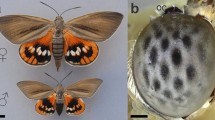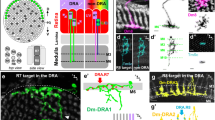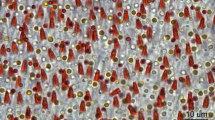Abstract
The spectral, angular and polarization sensitivities of photoreceptors in the compound eye of the monarch butterfly (Danaus plexippus) are examined using electrophysiological methods. Intracellular recordings reveal a spectrally homogenous population of UV receptors with optical axes directed upwards and ≥10° to the contralateral side. Based on optical considerations and on the opsin expression pattern (Sauman et al. 2005), we conclude that these UV receptors belong to the anatomically specialized dorsal rim area (DRA) of the eye. Photoreceptors in the main retina with optical axes <10° contralateral or ipsilateral have maximal sensitivities in the UV (λmax≤340 nm), the blue (λmax=435 nm) or in the long-wave range (green, λmax=540 nm). The polarization sensitivity (PS) of the UV receptors in the DRA is much higher (PS=9.4) than in the UV cells (PS=2.9) or green cells (PS=2.8) of the main retina. The physiological properties of the photoreceptors in the DRA and in the main retina fit closely with the anatomy and the opsin expression patterns described in these eye regions. The data are discussed in the light of present knowledge about polarized skylight navigation in Lepidopterans.







Similar content being viewed by others
Abbreviations
- DA:
-
Dorsal area
- DRA:
-
Dorsal rim area
- ERG:
-
Electroretinogram
- PS:
-
Polarization sensitivity
References
Aepli F, Labhart T, Meyer E P (1985) Structural specializations of the cornea and retina at the dorsal rim of the compound eye in hymenopteran insects. Cell Tissue Res 239:19–24
Anton-Erxleben F, Langer H (1988) Functional morphology of the ommatidia in the compound eye of the moth, Antheraea polyphemus (Insecta, Saturniidae). Cell Tissue Res 252:385–396
Barta A, Horvath G (2004) Why is it advantageous for animals to detect celestial polarization in the ultraviolet? Skylight polarization under clouds and canopies is strongest in the UV. J Theor Biol 226:429–437
Blum M, Labhart T (2000) Photoreceptor visual fields, ommatidial array, and receptor axon projections in the polarisation-sensitive dorsal rim area of the cricket compound eye. J Comp Physiol A 186:119–128
Briscoe AD, Bernard GD, Szeto AS, Nagy LM, White RH (2003) Not all butterfly eyes are created equal: Rhodopsin absorption spectra, molecular identification, and localization of ultraviolet-, blue-, and green-sensitive rhodopsin-encoding mRNAs in the retina of Vanessa cardui. J Comp Neurol 458:334–349
Briscoe AD, Bernard GD (2005) Eyeshine and spectral tuning of long wavelength-sensitive rhodopsins: no evidence for red-sensitive photoreceptors among five Nymphalini butterfly species. J Exp Biol 208:687–696
Burghause FMHR (1979) Structural specialization in the dorso-frontal region of the cricket compound eye (Orthoptera, Grylloidea). Zool Jb Physiol 83:502–525
Burkhardt D, Streck P (1965) Das Sehfeld einzelner Sehzellen: Eine Richtigstellung. Z Vergl Physiol 51:151–152
Coemans MAJM, Vos HJJ, Nuboer JFW (1994) The relation between celestial colour gradients and the position of the sun, with regard to the sun compass. Vis Res 34:1461–1470
Coulson KL (1988) Polarization and intensity of light in the atmosphere. A Deepak Publishing, Hampton
Duelli P, Wehner R (1973) The spectral sensitivity of polarized light orientation in Cataglyphis bicolor (Formicidae, Hymenoptera). J Comp Physiol 86:37–53
Dacke M, Nordstrom P, Scholtz CH, Warrant EJ (2002) A specialized dorsal rim area for polarized light detection in the compound eye of the scarab beetle Pachysoma striatum. J Comp Physiol A 188:211–216
Eguchi E, Watanabe K, Hariyama T, Yamamoto K (1982) A comparison of electrophysiologically determined spectral responses in 35 species of Lepidoptera. J Insect Physiol 28:675–682
Froy O, Gotter AL, Casselman AL, Reppert SM (2003) Illuminating the circadian clock in monarch butterfly migration. Science 300:1303–1305
Hämmerle B, Kolb G (1996) Retinal ultrastructure of the dorsal eye region of Pararge aegeria (Linné) (Lepidoptera: Satyridae). Int J Insect Morphol 25:305–315
Hardie RC (1984) Properties of photoreceptor-R7 and photoreceptor-R8 in dorsal marginal ommatidia in the compound eyes of Musca and Calliphora. J Comp Physiol 154:157–165
Von Helversen O, Edrich W (1974) Der Polarisationsempfänger im Bienenauge: ein Ultraviolettrezeptor. J Comp Physiol 94:33–47
Herzmann D, Labhart T (1989) Spectral sensitivity and absolute threshold of polarization vision in crickets: a behavioral study. J Comp Physiol A 165:315–319
Homberg U, Paech A (2002) Ultrastructure and orientation of ommatidia in the dorsal rim area of the locust compound eye. Arthropod Struct Dev 30:271–280
Homberg U (2004) In search of the sky compass in the insect brain. Naturwissenschaften 91:199–208
Kolb G (1985) Ultrastructure and adaptation in the retina of Aglais urticae (Lepidoptera). Zoomorphology 105:90–98
Kolb G (1986) Retinal ultrastructure in the dorsal rim and large dorsal area of the eye of Aglais urticae (Lepidoptera). Zoomorphology 106:244–246
Labhart T (1980) Specialized photoreceptors at the dorsal rim of the honeybee’s compound eye—polarizational and angular sensitivity. J Comp Physiol 141:19–30
Labhart T, Hodel B, Valenzuela I (1984) The physiology of the cricket’s compound eye with particular reference to the anatomically specialized dorsal rim area. J Comp Physiol 155:289–296
Labhart T (1986) The electrophysiology of photoreceptors in different eye regions of the desert ant, Cataglyphi bicolor. J Comp Physiol A 158:1–7
Labhart T, Meyer EP, Schenker L (1992) Specialized ommatidia for polarization vision in the compound eye of cockchafers, Melolontha melolontha (Coleoptera, Scarabaeidae). Cell Tissue Res 268:419–429
Labhart T, Meyer EP (1999) Detectors for polarized skylight in insects: a survey of ommatidial specializations in the dorsal rim area of the compound eye. Microscop Res Techn 47:368–379
Labhart T (1999) How polarization-sensitive interneurones of crickets see the polarization pattern of the sky: a field study with an optoelectronic model neurone. J Exp Biol 202:757–770
Labhart T, Petzold J, Helbling H (2001) Spatial integration in polarization-sensitive interneurones of crickets: a survey of evidence, mechanisms and benefits. J Exp Biol 204:2423–2430
Labhart T, Baumann F (2003). Evidence for a polarization compass in monarch butterflies. Proc Neurobiol Conf Göttingen 29:545
Mappes M, Homberg U (2004) Behavioral analysis of polarization vision in tethered flying locusts. J Comp Physiol A 190:61–68
Meinecke CC (1981) The fine-structure of the compound eye of the African armyworm moth, Spodoptera exempta Walk (Lepidoptera, Noctuidae). Cell Tissue Res 216:333–347
Meyer E P, Labhart T (1981) Pore canals in the cornea of a functionally specialized area of the honey bee’s compound eye. Cell Tissue Res 216:491–501
Meyer E P, Labhart T (1993) Morphological specializations of dorsal rim ommatidia in the compound eye of dragonflies and damselflies (Odonata). Cell Tissue Res 272:17–22
Mouritsen H, Frost B J (2002) Virtual migration in tethered flying monarch butterflies reveals their orientation mechanisms. Proc Natl Acad Sci USA 99:10162–10166
Nilsson D E, Labhart T, Meyer E P (1987) Photoreceptor design and optical properties affecting polarization sensitivity in ants and crickets. J Comp Physiol A 161:645–658
Perez S M, Taylor O R, Jander R (1997) A sun compass in monarch butterflies. Nature 387:29
Von Philipsborn A, Labhart T (1990) A behavioral study of polarization vision in the fly, Musca domestica. J Comp Physiol A 167:737–743
Reppert SM, Zhu H, White RH (2004). Polarized light helps monarch butterflies navigate. Curr Biol 14:155–158
Seliger HH, Lall AB, Biggley WH (1994) Blue through UV polarization sensitivities in insects: optimizations for the range of atmospheric polarization conditions. J Comp Physiol A 175:475–486
Sauman I, Briscoe AD, Zhu HS, Shi DD, Froy O, Stalleicken J, Yuan Q, Casselman A, Reppert SM (2005) Connecting the navigational clock to sun compass input in monarch butterfly brain. Neuron 46:457–467
Stalleicken J, Mukhida M, Labhart T, Wehner R, Frost B, Mouritsen H (2005). Do monarch butterflies use polarized skylight for migratory orientation? J Exp Biol 208:2399–2408
Stavenga DG, Smits RP, Hoenders BJ (1993) Simple exponential functions describing the absorbency bands of visual pigment spectra. Vis Res 33:1011–1017
Ukhanov KY, Leertouwer HL, Gribakin FG, Stavenga DG (1996) Dioptrics of the facet lenses in the dorsal rim area of the cricket Gryllus bimaculatus. J Comp Physiol A 179:545–552
Wehner R, Bernard GD, Geiger E (1975) Twisted and non-twisted rhabdoms and their significance for polarization detection in the bee. J Comp Physiol 104:225–245
Wehner R (1982) Himmelsnavigation bei Insekten Neurophysiologie und Verhalten. Neujahrsbl Naturforsch Ges Zürich 184:1–132
Wehner R (1984) Astronavigation in insects. Annu Rev Entomol 29:277–298
Wehner R, Bernard GD (1993) Photorecptor twist: a solution to the false-color problem. Proc Natl Acad Sci USA 90:4132–4235
Wehner R (1994) The polarization-vision project: championing organismic biology. In: Schildberger K, Elsner N (eds) Neural basis of behavioural adaption. G Fischer, Stuttgart, pp 103–143
Wehner R (1996) Polarisationsmusteranalyse bei Insekten. Nova Acta Leopoldina NF 72:159–183
Wehner R (1997) The ant’s celestial compass system: spectral and polarization channels. In: Lehrer M (eds) Orientation and communication in Arthropods. Birkhäuser, Basel, pp 145–185
Wehner R, Labhart T (2005) Polarization vision. In: Warrant E, Nilsson D-E (eds) Invertebrate vision. Cambridge University Press (in press)
White RH, Xu HH, Munch TA, Bennett RR, Grable EA (2003) The retina of Manduca sexta: rhodopsin expression, the mosaic of green-, blue- and UV-sensitive photoreceptors, and regional specialization. J Exp Biol 206:3337–3348
Wolf R, Gebhardt B, Gademann R, Heisenberg M (1980) Polarization sensitivity of course control in Drosophila melanogaster. J Comp Physiol 139:177–191
Zufall F, Schmitt M, Menzel R (1989) Spectral and polarized-light sensitivity of photoreceptors in the compound eye of the cricket (Gryllus bimaculatus). J Comp Physiol A 164:597–608
Acknowledgements
The Volkswagen Stiftung (Nachwuchsgruppe grant to H. M.), University of Oldenburg (to H. M. and J. S.), the DAAD (to J. S.) and the Swiss National Science Foundation grant 31-61844.00 (to T. L.) kindly provided financial support for this project. We would like to thank Gary D. Bernard for fruitful discussions.
Author information
Authors and Affiliations
Corresponding author
Rights and permissions
About this article
Cite this article
Stalleicken, J., Labhart, T. & Mouritsen, H. Physiological characterization of the compound eye in monarch butterflies with focus on the dorsal rim area. J Comp Physiol A 192, 321–331 (2006). https://doi.org/10.1007/s00359-005-0073-6
Received:
Revised:
Accepted:
Published:
Issue Date:
DOI: https://doi.org/10.1007/s00359-005-0073-6




